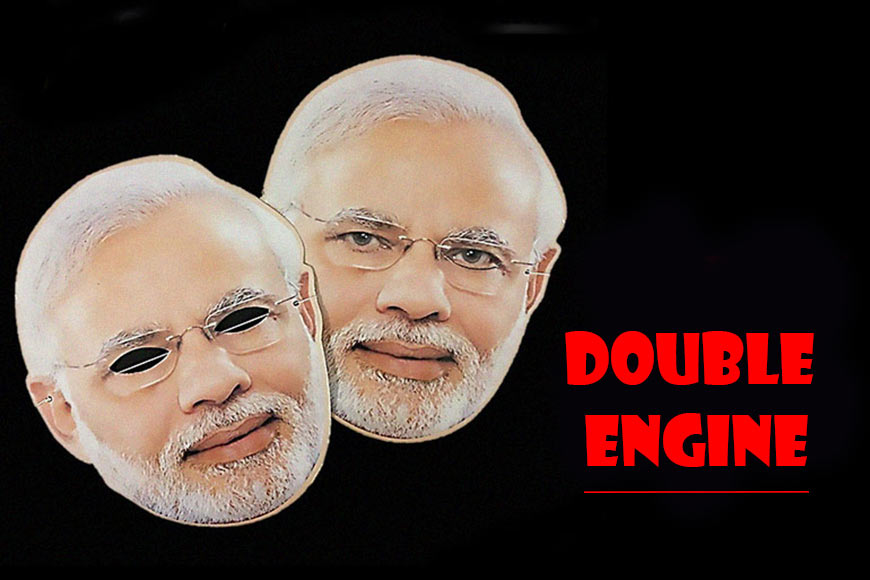‘Double engine’: Has Modi forgotten how his own party was born?

A total of four states and one Union Territory are going to the polls during the current Assembly elections in India - West Bengal, Kerala, Tamil Nadu, Assam, Kerala, and Puducherry. Prime Minister Narendra Modi and Home Minister Amit Shah have dropped everything else to become campaigners for their party, and are running around the country. During his campaigns, Modi has coined a slogan, the sum of which is that the people of the country apparently want the same party in power at both state and central levels. And it is this ‘double engine’ that holds the key to development.
On the surface, this seems to make sense. However, if you look beyond the slick phraseology, you will discover the origins of the BJP, which the lion of Gujarat seems to have forgotten. The party and the symbol that he is loyal to were born in 1979, formed by members of the Hindu Mahasabha, Jana Sangh, and RSS once Jayprakash Narayan’s Janata Party broke up.
It was in this ‘double engine’ template that veteran Gandhian Jayprakash Naryan saw signs of autocracy, and called for a mass movement bereft of any party colours. This was the fuel that drove the Emergency, leading to widespread arrests and press censorship.
However, BJP supporters and ordinary voters alike must remember the history of the decade preceding the birth of the new party. In 1969, the Congress split into two. And in 1971, riding on the success of the Bangladesh War, Indira Gandhi won a two-thirds majority in Parliament. At that point, the Congress was in power in every state in the country. Even in the South, Achyut Menon in Kerala or M.G. Ramachandran in Tamil Nadu were running their governments with Congress support. In 1972, West Bengal held Assembly elections, which turned into a farce under the able guidance of the Siddhartha Shankar Ray administration. Not even Jyoti Basu managed a win from Baranagar, and the word “rigging” found a permanent place in Indian politics.
It was in this ‘double engine’ template that veteran Gandhian Jayprakash Naryan saw signs of autocracy, and called for a mass movement bereft of any party colours. This was the fuel that drove the Emergency, leading to widespread arrests and press censorship. In 1977, this was the backdrop against which Indira suffered her electoral defeat, bringing to power the first non-Congress government, under the stewardship of Morarji Desai. In his cabinet were two members called Atal Bihari Vajpayee and Lalkrishna Advani. In the same year, from Kashmir to Kanyakumari, various states voted non-Congress governments to power.
Modi perhaps needs to be reminded that in 1957, the third general elections brought a Communist government to power in Kerala, going against the double engine narrative. When Modi himself became chief minister of Gujarat, the Congress was in power at the Centre, so his rise to power has been propelled by a single engine.
Ever since Independence, the Congress leadership had been talking about this double engine. Narayan’s movement was designed to prove them wrong, and it was this that led to the birth of the BJP. After a mere seven years in power, the BJP under Modi has begun dreaming that same dream, quite forgetting the reason behind the birth of their own party.
Modi perhaps needs to be reminded that in 1957, the third general elections brought a Communist government to power in Kerala, going against the double engine narrative. When Modi himself became chief minister of Gujarat, the Congress was in power at the Centre, so his rise to power has been propelled by a single engine. Whether it was the Congress in the 1970s or the BJP now, the double engine theory completely ignores the individual voices of the states.
Thought leaders of the BJP, the likes of Savarkar-Hegdewar-Munje, played no role in the drafting of the Constitution, neither did they support a secular nation. However, the tidal wave of Jayprakash Narayan’s movement had, if only for a time, caused the BJP to be in favour of a multi-party system.
This is absolutely contrary to what the Indian Constitution says about the federal principles upon which India has been built. Hence the term ‘federal nation’. The same Congress leaders who were responsible for drafting these principles then proceeded to follow a unitary model of government for the next three decades.
Thought leaders of the BJP, the likes of Savarkar-Hegdewar-Munje, played no role in the drafting of the Constitution, neither did they support a secular nation. However, the tidal wave of Jayprakash Narayan’s movement had, if only for a time, caused the BJP to be in favour of a multi-party system. Post-2014 however, having tasted blood under the Modi-Shah leadership, the party is now changing colour. And that is why Modi wants his double engine.










